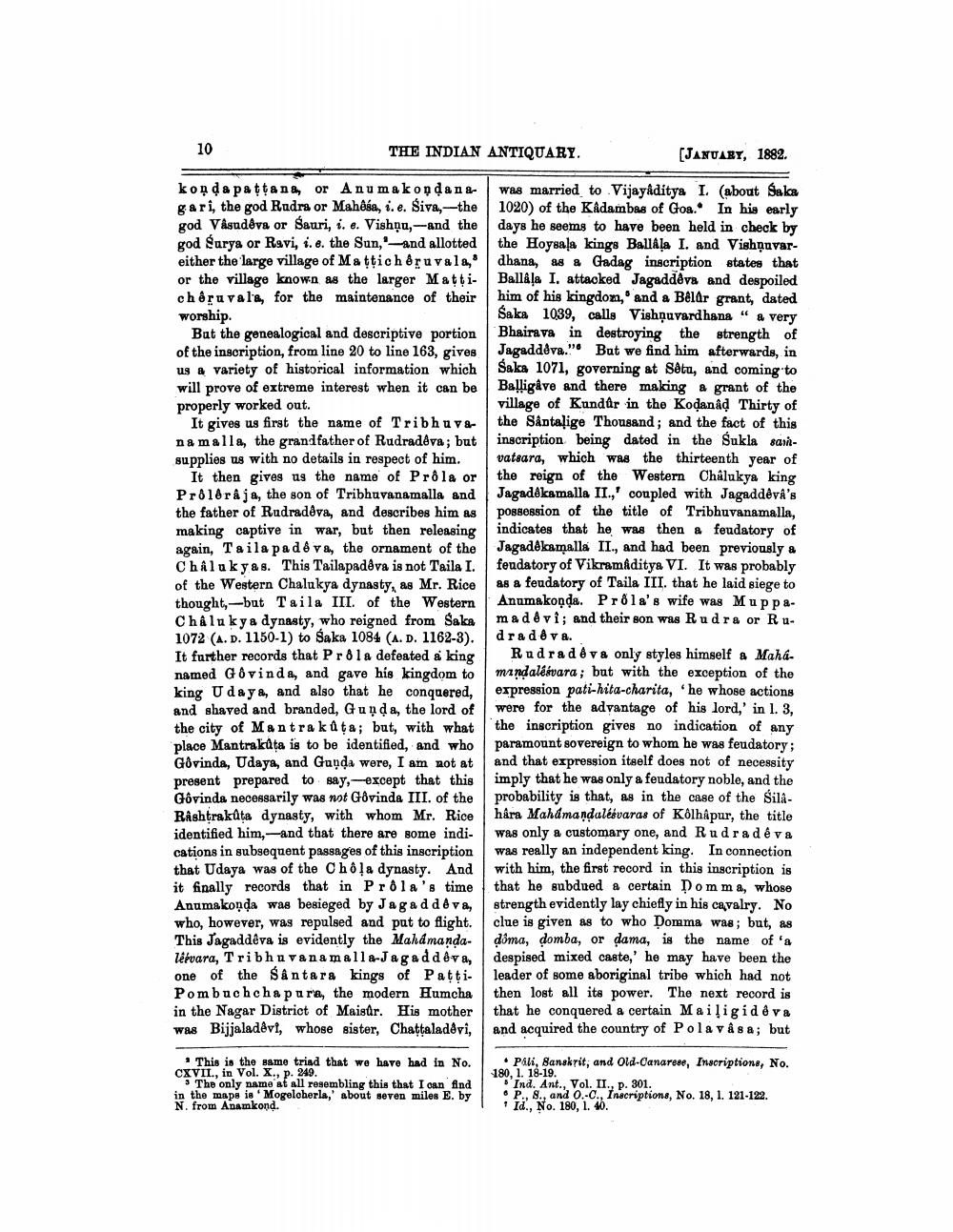________________
10
THE INDIAN ANTIQUARY.
(JANUABY, 1882.
kond a pattana, or Anumakondanggari, the god Rudra or Mahesa, i.e. Śiva,--the god Vasudeva or Sauri, 1. e. Vishņu,--and the god Sarya or Revi, 1. e. the Sun, and allotted either the large village of Matticheruvala, or the village known as the larger Mattichêru vald, for the maintenance of their worship.
But the genealogical and descriptive portion of the inscription, from line 20 to line 163, gives us a variety of historical information which will prove of extreme interest when it can be properly worked out.
It gives us first the name of Tribhuvenamalla, the grandfather of Rudraddva; but supplies us with no details in respect of him.
It then gives us the name of Prola or Prðlərå ja, the son of Tribhuvanamalla and the father of Rudradeva, and describes him as making captive in war, but then releasing again, Taila padê vay the ornament of the Chåluk yas. This Tailapadeva is not Taila I. of the Western Chalukya dynasty, as Mr. Rice thought---but Taila III. of the Western Chalukya dynasty, who reigned from Saka 1072 (A.D. 1150-1) to Saka 1084 (A.D. 1162-3). It further records that Prola defeated a king named Govinda, and gave his kingdom to king Udaya, and also that he conquered, and shaved and branded, Guņda, the lord of the city of Mantra kata; but, with what place Mantrakåta is to be identified, and who Govinda, Udaya, and Ganda were, I am not at present prepared to say, except that this Govinda necessarily was not Govinda III. of the Rashtrakūta dynasty, with whom Mr. Rice identified him,-and that there are some indications in subsequent passages of this inscription that Udaya was of the Chô la dynasty. And it finally records that in Prola's time Anumakonda was besieged by Jagad d dva, who, however, was repulsed and put to flight. This Jagaddēva is evidently the Mahamandalébvara, Tribhuvanamalla-Jagad d dva, one of the Santara kings of PattiPombuchcha pura, the modern Humcha in the Nagar District of Maistr. His mother Was Bijjaladevi, whose sister, Chattaladevi,
was married to Vijayaditya I. (about Saka 1020) of the Kadambas of Goa. In his early days he seems to have been held in check by the Hoysala kings Ballála I. and Vishạnvardhana, as a Gadag inscription states that Ball&ļa I. attacked Jagaddeva and despoiled him of his kingdon, and a Belar grant, dated Saka 1039, calls Vishņuvardhana" a very Bhairava in destroying the strength of Jagadddva."* Bat we find him afterwards, in Saka 1071, governing at Satu, and coming to Balligåve and there making a grant of the village of Kundar in the Kodanad Thirty of the Santalige Thousand; and the fact of this inscription being dated in the Sukla sartvatsara, which was the thirteenth year of the reign of the Western Châlukya king Jagadókamalla II.,' coupled with Jagaddeva's possession of the title of Tribhuvanamalla, indicates that he was then a feudatory of Jagadėkamalla II., and had been previously & fendatory of Vikramaditya VI. It was probably as a feudatory of Taila III. that he laid siege to Anumakonda. Prðla's wife was Muppamade vi; and their son was Rudra or Rudrad êva.
Rudraddva only styles himself a Mahamandalesvara ; but with the exception of the expression pati-hita-charita, "he whose actions were for the advantage of his lord,' in l. 3, the inscription gives no indication of any paramount sovereign to whom he was feudatory; and that expression itself does not of necessity imply that he was only a feudatory noble, and the probability is that, as in the case of the Silahâra Mahdmandalesvaras of Kolhapur, the title was only a customary one, and Rudra de va was really an independent king. In connection with him, the first record in this inscription is that he subdued a certain Domma, whose strength evidently lay chiefly in his cavalry. No clue is given as to who Domma was; but, as doma, domba, or dama, is the name of a despised mixed caste,' he may have been the leader of some aboriginal tribe which had not then lost all its power. The next record is that he conquered a certain Maiļigide va and acquired the country of Pola vâsa; but
• This is the same triad that we have had in No. CXVII., in Vol. X., p. 249.
3 The only name at all resembling this that I can find in the maps is Mogelcherla,' about seven miles E. by N. from Anamkond.
• Pali, Sanskrit; and Old-Canarese, Inscriptione, No. 180, 1. 18-19.
'Ind. Ant., Vol. II, p. 301.
P., 8., and 0.-C., Inscriptions, No. 18, 1. 121-122. + Id., No. 180, 1. 40.
1




